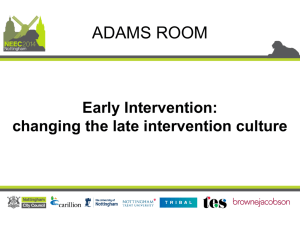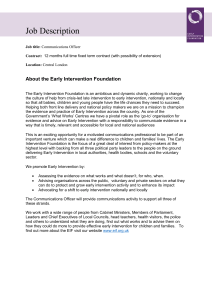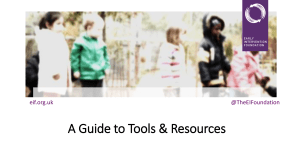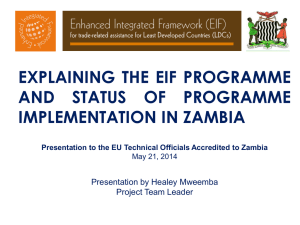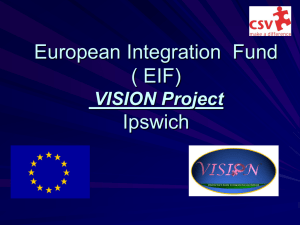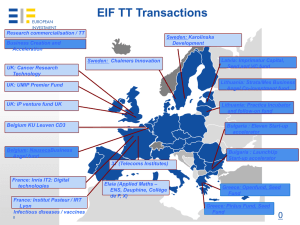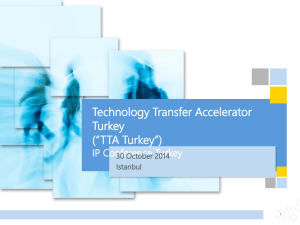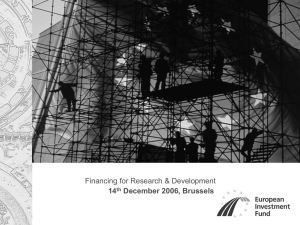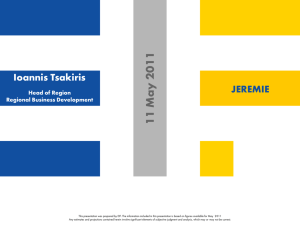The Enhanced Integrated Framework (EIF) at WTO
advertisement
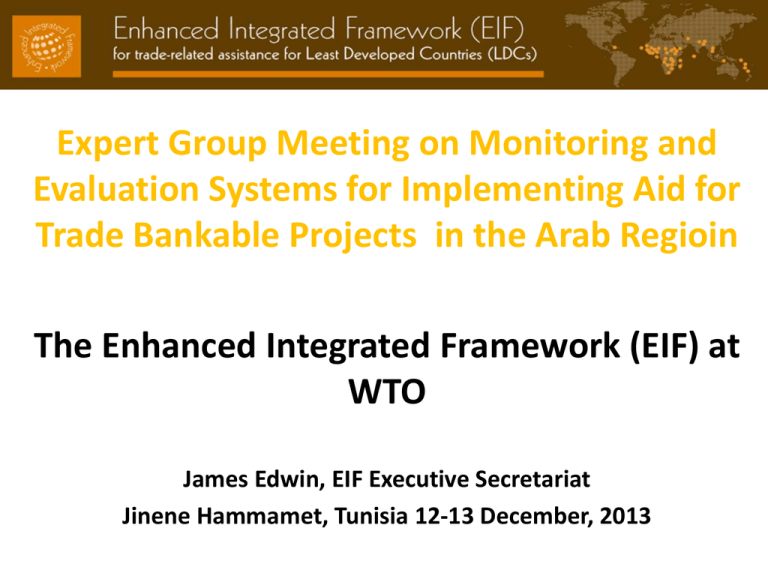
Expert Group Meeting on Monitoring and Evaluation Systems for Implementing Aid for Trade Bankable Projects in the Arab Regioin The Enhanced Integrated Framework (EIF) at WTO James Edwin, EIF Executive Secretariat Jinene Hammamet, Tunisia 12-13 December, 2013 Presentation Sequencing 1. EIF/WTO and its Governance Structure 2. What is an eligible Bankable AfT project for EIF funding? 3. The EIF Tier 2 project cycle 4. Role of M&E in EIF Project LDC match to join the global trading system What is the EIF and its Governance Structure What is the EIF and its Governance Structure • The EIF is an Aid for Trade (AfT) partnership which support Least Developed Countries (LDCs) to be more active players in the global trading system • The global partnership includes 49 LDCs, 23 donors and 6 Core Agencies, 1 Observer Agency, the EIF Executive Secretariat (ES), the EIF Trust Fund Manager (TFM) and other development partners The EIF and its Governance Structure Global Level EIF Steering Committee EIF Board ES and TFM Country Level EIF National Steering Committee TAC 1&2 Focal Point/NIU Donor Facilitator ES and TFM What is the EIF and its Governance Structure The EIF aims at creating a strong and effective results -oriented partnership to trade through: • Mainstreaming trade into national development strategies; • Setting up structures needed to coordinate the delivery of Trade-related Technical Assistance (TRTA); • Build capacity to trade, which also includes addressing critical supply-side constraints. What type of Aid for Trade support does EIF provide? & EIF Bankable Project What is an EIF/WTO bankable Project EIF uses two windows to fund projects: Tier 1 and Tier 2 Tier 1 Tier 2 Bankable project is a Tier 2 project which is aimed at assisting in the implementation of priority projects identified in the DTIS Action Matrix. What is an EIF/WTO Bankable Project These priority projects should be: strategically selected to complement existing projects or fill gaps; Also where appropriate, small, low-cost and strategic projects are consolidated into a broader Tier 2 project. Types of Tier 2 projects Trade policy and regulation (e.g. helping countries to develop trade strategies, WTO accession, implement WTO commitments, and trade mainstreaming activities, build ministry capacity to implement trade strategies) Trade-related infrastructure. (e.g. small roads, ports to connect domestic markets to the global economy, customs, standards and quality infrastructure) Building productive capacity (e.g. supporting the to private sector/small businesses to exploit their comparative advantages and diversify their products, tourism) Trade-related adjustment (Non at the moment) Types of Tier 2 projects cont…… Small infrastructure projects may also be considered by the EIF Board on a case-by-case basis if they are of a limited and focused scope; if they address a supply-side constraint that has been identified in the DTIS Action Matrix; and if they are part of the implementation of the midterm programme. Funding of Tier 2 Projects Funding comes from a multi donor trust fund (EIFTF); The bulk will need to come from programmes funded by bilateral or multilateral Development Partners (DPs); While cost-sharing with EIF Country governments is encouraged, modalities for co-funding by other donors are yet in the works. What is the process for an EIF Bankable Tier 2 Project ? Process for a Tier 2 Project For EIFTF Project must come from DTIS Action Matrix; Project prioritised through consultation between all country level stakeholders; Project must be approved by the EIF National Steering committee; Process for a Tier 2 Project For EIFTF The Focal Point supported by the Donor Facilitator needs to have ensured that the proposed project does not duplicate any projects in the pipeline of any bilateral or multilateral donors; The project should have true country ownership. EIF Value for Money Bankable Project Development Process Submit final project proposal to EIF Board for approval Finalise project proposal with guidance from technical experts and ES /TFM Share draft proposal document with EIF ES and TFM Expand the logframe into a full project proposal Develop the logframe: the project ‘backbone‟ What is the role of M&E in EIF supported Projects? M&E in the Results Chain Planning Input Process/ Activities Output Implementation monitoring Influenced by Management Outcome Impact Performance monitoring External forces • Effective M&E leads to an efficient Results-based management system (RBM); • In project management, RBM is a management strategy focusing on performance and achievement of results. 18 Monitoring at all stages of the project cycle Programming/ Planning Evaluation Implementation Identification Formulation Financing Appraisal Impact Outcome Outputs ‘Hope to see’ Trade activity improves , household income increased, economic development improved ‘Want to see’ More products are sold because of access to market; journey time reduced. 300 km of road is completed and/ or repaired Activities Construction and repair of roads occurs Inputs Funds for road construction, equipment staff provided (c) EIF 2011 IDENTIFY Key Performance INDICATORS (KPI) Baselines, Milestones and Targets • One of the key strengths of the logframe approach is that it forces the planning team to build into the design how the project will be monitored and evaluated; • Indicators and verification are needed to show what data we intend to use to measure progress, and how that data will be collected • In most circumstances there is not enough baseline data available at the design stage against which progress can be measured; in which case the logframe helps to pinpoint the gaps and determine what needs to be done. How do we focus M&E in RBM Strategic planning Defining clear and measurable results and indicators, based on a logic model or framework Measuring and describing progress towards results, and the Monitoring resources consumed, using appropriate indicators. Reporting Reporting on progress towards results, internally and externally. Evaluation -To take stock of the results achieved; -To inform decision on programme extension; -To identify lessons learned, which would inform program design. Managing Using results information (and evaluation) for lesson-learning and management decision making. 22 What is the Evaluation Component of the EIF Levels of Evaluation 3 levels of evaluation for the EIF: 1) Mid-term review (useful to consider revision of objectives) 2) End of project or final evaluation (to assess the achievement of the project purpose) 3) Ex-post or impact evaluation (to assess sustained benefits and overall impact) Optional 1) Ex Ante- Feasibility Studies EVALUATION • Assesses the relevance, efficiency, effectiveness, impact and sustainability of projects in relation to stated objectives; • It links results-to-purpose and purpose-to-overall objectives of the project/program; • It is based on the guiding principles of impartiality, independence and credibility. Ways to evaluate inputs, activities, outputs outcomes and impacts are essential components of M&E. Results Chain immediate immediate 6months – 1 year After implementation Inputs Activities Outputs Project / Department Level Indicators 2 to 5 years Outcomes National Level Indicators 5 years or more Impact (Goal) Designing Good Evaluations • Getting the questions right is critical • Answering the questions is critical • Supporting public sector decision-making with credible and useful information is critical “Better to have an approximate answer to the right question, than an exact answer to the wrong question.” Paraphrased from statistician John W. Tukey This Concludes the Presentation EIF Executive Secretariat at the WTO: email: eif.secretariat@wto.org Web: www.enhancedif.org Planning a Monitoring System Purpose: • Serve as the basis for establishing the project’s information systems • Generate information that will allow project managers to: – track achievement of project outputs (immediate results of project activities) , and – monitor progress towards achievement of objectives and desired outcomes (interim results created by outputs) 29 Planning a Monitoring System 1. What should be monitored? – Keep information requirements to a bare minimum – Collect info that will be most helpful to those who will use it 2. How? – Select methods to track indicators/report on progress • • • • Observations, interviews, routine reporting, sentinel sites Piggyback on existing data collection systems Both formal/informal and quantitative/qualitative methods Decide how information will be recorded systematically and reported clearly (use software e.g. excel, access, MS project, Prince 2, other specialized software) • Consider the time and skills of those who will collect the data • Pretest new monitoring instruments 30 Planning a Monitoring System 3. Who should be involved when? – Clearly identifying who will collect information on indicators, when (frequency) and who will receive it – The monitoring plan should also identify who will be involved in reviewing progress and providing feedback 4. What resources are needed and available? – The human and financial cost of gathering, reporting and reviewing data should be identified – Needed funding and time should be set aside for this work 31 Planning a Monitoring System 5. Consultation and Training – Discuss the monitoring program with a representative group from each level before it is put into effect – Provide training to those who will be using the monitoring systems 6. Using your M&E Framework Prepare a workplan – for each year – listing the main activities to be carried out, their output, timing and parties involved 32 LEVELS OF INDICATORS • Impact-Level – indicators that show to what extent the project has contributed to achievement of its goals • Outcome-Level– indicators that show to what extent planned results at output and outcome or purpose level have been achieved • Ouput Level – indicators that show whether activities planned have been carried out and how. Also, used as measure of outputs • Activities – indicators that show what activities have been completed • Input Indicators – indicators that show what resources have been used by the project EIF outcomes (Results) and measurable indicators (NIU) RESULT LEVEL RESULT STATEMENT Goal LDCs‘ integration into the global trading system with a view to contributing to poverty reduction and sustainable development Purpose To enable EIF Countries to become fully integrated and active players in, and beneficiaries of, the global trading system through mainstreaming trade. Outcomes 1. EIF Countries mainstream trade into their national development strategies and plans 1. Coordinated delivery of trade-related resources (funding, technical assistance, etc.) by donors and implementing agencies to implement country priorities following the adoption of the DTIS Action Matrix 1. EIF Countries secure resources in support of initiatives that address DTIS Action Matrix priorities 1. Sufficient institutional and management capacity is built in EIF Countries to formulate and implement trade-related strategies and implementation plans INDICATORS G1: LDC Members of WTO who have completed the accession process. G2: Per cent share of international non-oil trade from LDCs. G3: Poverty head count. G4: Per capita growth rate G5: Gini-coefficient P1: Value of non-oil goods traded P2: Non-oil goods trade diversification. P3: Logistics performance Index (LPI). P4: World Bank Doing Business – trading across borders. P5: Employment in non-traditional export sectors. P6: SMEs registered for import and export trade. O1.1: Tier 1 ‘Support to NIAs‘ project completed or under implementation in EIF Countries. O1.2: Number (and per cent) of active EIF Countries with complete, up-to-date (less than three years old) validated DTIS Action Matrices. O1.3: Level of capacity of the NIU to perform fiduciary programme management function for Tier 1 ‘Support to NIAs‘ project. O1.4: Number of EIF Countries with up-to-date (not older than five years) trade strategies. O1.5: Number of EIF Countries with quality trade strategies. O1.6: Number of EIF Countries with quality trade strategy implemented. O1.7: Number of EIF-funded projects achieving the expected results. O2.1: Trade in PRSP and/or national development strategies O2.2: Existence of productive sector strategies for key sectors, integrating the trade dimension. O2.3: Functioning public/private consultation mechanism. O3.1: Availability of an annual rolling implementation overview integrating all trade-related government and donorsupported activities (where applicable, identifying activities specifically addressing gender and the environment). O3.2: Frequency of government and donor consultations on trade-related matters. O3.3: UN CEB Cluster activities are based on DTIS Action Matrix priorities in EIF Countries. O3.4: Number of countries with joint donor initiatives in the trade area (such as needs assessments; strategy formulations; programming; pooled funding; M&E; etc.). O4.1: Number of EIF Countries with implementation plan integrating DTIS/Action Matrix priorities and indicating financing needs to be met through ODA. O4.2: Number of EIF Countries where a government budget exists for the implementation of its trade strategy. O4.3: AfT flows to EIF Countries. O4.4: Number and amount of projects funded by donors related to the DTIS Action Matrix. [1] Note how these outcomes correspond with the principles of the Paris Declaration and how the programme works to strengthen LDCs’ capacity to take ownership of and provide leadership around trade and development support related Example M&E Framework Indicators Goal/ Impact Outcome Output Define Indicator Baseline Target Sources of Assumptio Verification ns Example M&E Plan Example of a M&E plan for one indicator Data Collection & Reporting Indicators Base Line & Target Values (/Year) (Definition % unit) BL Y1 Y2 YN Target Frequency/S chedule Annually (June) Instrument (Method) Responsible Party Routine administrative records Ministry of Trade 10 The Annual Work Plan Year_______ Project Title______________________ Implementing Agency ________________ EXPECTED OUTPUTS AND INDICATORS INCLUDING ANNUAL TARGETS OUTPUT 1: INDICATOR 1.1 WITH TARGET FOR THE YEAR: INDICATOR 1.2 WITH TARGET FOR THE YEAR: INDICATOR 1.3 WITH TARGET FOR THE YEAR: OUTPUT 2: INDICATOR 2.1WITH TARGET FOR THE YEAR: ETC. PLANNED ACTIVITIES List all the activities including monitoring and evaluation activities to be undertaken during the year towards stated outputs EXPENDI TURES List actual expenditures against activities completed RESULTS OF ACTIVITIES For each activity, state the extent of delivery PROGRESS TOWARDS ACHIEVING Results Using data on annual indicator targets, state progress towards achieving the outputs. Where relevant, comment on factors that facilitated and/or constrained achievement of results
